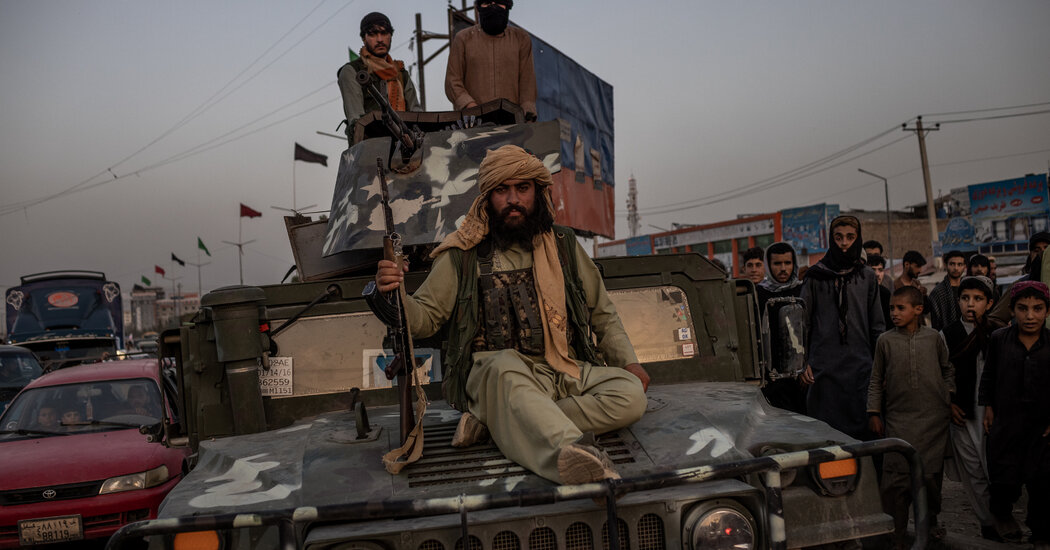In Afghanistan, August 2021 began ominously.
The Americans and their allies were leaving the country, finally ending their long war after striking an agreement with the Taliban, and leaving the country’s defense to the security forces they had trained and supplied for years. But the Afghan forces were already beginning to buckle. By the end of the summer, the insurgents had seized dozens of districts, rapidly sweeping across the countryside as outpost after outpost folded.
But none of the 34 provincial capitals had fallen. Yet.
The United States was proing limited air support to the beleaguered Afghan forces below and there remained a small hope that the U.S.-sponsored firepower would continue after the United States withdrew completely. President Ashraf Ghani had reshuffled his military leadership, and militia units led by the powerful and notorious warlords of Afghanistan’s past had taken up arms to defend their economic fiefs.
Then, on Aug. 6, Zaranj, the capital of Nimroz Province on the border with Iran, suddenly fell to the Taliban. Like dominoes, other provincial capital cities began toppling as well, even in places like Kandahar where the Afghan forces had defended well for months.
By the morning of Aug. 15, the Taliban had practically encircled Kabul, the country’s capital, and thousands of U.S. troops had landed to evacuate the American Embassy.
By the end of the day, the Western-backed government, including Mr. Ghani, had fled, and the American flag over the embassy had been taken down. What would become crowds of tens of thousands of Afghans began forming at the gates of the international airport, fearful of what their new Taliban rulers would do.
Others, though, were relieved, grateful that a violent siege of the city, much like what had happened during the civil war of the 1990s, had been avoided. When the insurgent group entered Kabul, some city neighborhoods celebrated their arrival.
Instead, the violence centered around the airport, as the crowds surged toward the gates, wedged between the rifle butts of the Taliban — desperate to establish security in the sprawling capital of around five million people — and the rifle barrels of the Americans defending the gates.
By the month’s end, tens of thousands of Afghans had been evacuated from Kabul to countries all over the world. The last American cargo jets had departed, leaving behind blowing trash and celebratory Taliban gunfire. Thirteen Americans and nearly 200 Afghans were killed in an Islamic State suicide bomb blast, and soon after the U.S. responded by errantly killing 10 civilians in an airstrike intended to punish ISIS.
The ending to the long American war in Afghanistan had been short and violent, and now a new chapter of Taliban rule was opening, as the group tried to suddenly shift from a guerrilla insurgency into a government for around 40 million Afghans.
Now, we have seen that the Taliban have, in fact, returned to many of the repressive and hard-line ways that characterized their regime in the 1990s. But as the summer ended last year, nothing was clear except that the world had changed, in just a blink.
Above and below, Kabul in early July last year.
At a security checkpoint in Herat for vehicles and motorbikes arriving into the city from a nearby Taliban-controlled area in mid-July 2021.
Afghan commandos in July in Kunduz, a provincial capital in northern Afghanistan that Taliban insurgents had cut off on all sides.
A woman and children fleeing their house in Kandahar, Afghanistan, on Aug. 4, 2021.
A Taliban fighter trying to hit a woman who was waiting to enter the Kabul airport with her family on Aug. 18, 2021.
Khalil Haqqani, a prominent figure among the Taliban, at Friday prayer at the Pul-i-Khishti mosque in Kabul, on Aug. 20, 2021.
A defaced beauty shop window display in Kabul on Aug. 22, 2021.
Passengers waiting to clear a security checkpoint for one of the last commercial flights from Kabul on Aug. 15 as Taliban forces closed in to take control of the city.
Afghans waving their documents at U.S. Marines standing guard atop the blast walls at the Kabul airport on Aug. 22, 2021.
Survivors of the devastating ISIS suicide bomb attack at Kabul airport arriving at Emergency Hospital on Aug. 26, 2021.
Afghans flee from the Taliban police during a protest in Kabul on Sept. 7, 2021.
Nematullah Naqdi, 28, left, and Taqi Daryabi, 22, journalists working for Etilaat Roz, show their wounds after being beaten by the Taliban while they covered a Kabul protest on Sept. 8.
Both the father and fiancé of Samia Ahmadi, right, were killed on Sunday in a U.S. drone strike on a house in Kabul on Aug. 30, 2021.
Hussain, 40, was one of as many as 170 civilians killed in the ISIS bombing at Kabul Airport on Aug. 26.
Members of the Taliban’s Badri 313 Battalion performing evening prayers at the airport in Kabul on Aug. 28, 2021.



